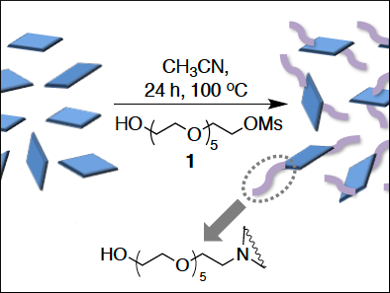Fluorescent materials can be used for the imaging of living cells. The development of heavy-metal-free, water-dispersible, and biocompatible imaging probes is important. Carbon nitride (C3N4) has suitable optical properties for a bioimaging probe, but its biocompatibility and dispersibility in aqueous media need to be enhanced.
Yong Jin Lee, Korea Institute of Radiological and Medical Sciences, Seoul, Sungjin Park and Dong Wook Kim, Inha University, Incheon, Republic of Korea, and colleagues have incorporated short chain polyethylene glycol (PEG) groups onto a carbon nitride network to solve these problems. The team used an N-alkylation of hexaethylene glycolic mesylate with nucleophilic nitrogen atoms on oxidized carbon nitride (OCN, reaction pictured).
The PEGylated OCN (PEG-OCN) is well dispersed in water as nanodots and shows strong photoluminescence in the visible region. The team used cell viability testing to confirm that these heavy-metal-free, organic nanodots are highly biocompatible and non-cytotoxic. In particular, the developed nanodots could provide clear confocal images of a type of mouse cell without weakening cell activity, while displaying bright green emission.
- Thin PEGylated Carbon Nitrides: Water-Dispersible Organic Nanodots as Bioimaging Probes,
Jin Kwan Kim, Sunghee Park, Ran Ji Yoo, Hyeon Jin Jeong, Junghoon Oh, Yong Jin Lee, Sungjin Park, Dong Wook Kim,
Chem. Eur. J. 2017.
https://doi.org/10.1002/chem.201704761



